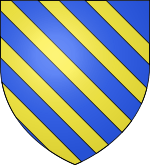William II, Lord of Béthune
William II, Lord of Béthune, nicknamed William the Red (French: Guillaume II « le Roux » de Bethune; d. April 1214) was French nobleman. He was a ruling Lord of Béthune, Richebourg and Warneton, as well as hereditary advocatus of the Abbey of St. Vaast, near Arras.
William II, Lord of Béthune | |
|---|---|
 Ancient coat of arms of the House of Béthune | |
| Died | April 1214 |
| Noble family | House of Bethune |
| Spouse(s) | Mathilda of Dendermonde |
| Father | Robert V, Lord of Béthune |
| Mother | Adelaide of Saint-Pol |
Family
He was a member of the influential House of Bethune, who had their ancestral seat in Béthune in the Artois region. He was the second son of Lord Robert V, nicknamed Robert the Red, and his wife Adelaide of Saint-Pol. His brothers were:
- Robert VI (d. 1193)
- Baldwin (d. 1212)
- Conon (d. 1219 or 1220), a famous troubadour and crusader
- Jean (d. 1219), bishop of Cambrai
Life
William II and his elder brother Robert VI accompanied their father in the armed escort of Count Philip I of Flanders when he made a pilgrimage to the Holy Land in 1177. When they arrived in the Kingdom of Jerusalem, William II and Robert VI wanted to marry Sibylla and Isabella, the sisters of King Baldwin IV of Jerusalem. The King, however, turned them down.[1][2]
In 1191, the Béthune family, now including the younger brothers Baldwin and Conon, accompanied Count Philip I and their father on another pilgrimage to the Third Crusade. During the crusade, both Philip I and Robert V died.
When Robert VI died childless in 1193, William II inherited the Béthune family possessions. He married Mathilda, the heiress of Dendermonde and had several children with her.
Members of the Béthune family had divided loyalties in the conflict between King Philip II of France and Count Baldwin IX of Flanders about who was the rightful liege lord of Artois. William II and his oldest son Daniel sided with France, while his younger brothers and his son Robert VII sided with Flanders.
On 23 February 1200, William II and Conon departed to accompany Count Baldwin during the Fourth Crusade. Conon became famous for his heroic deeds; William's actions were less noticeable. He was present when the crusaders took Constantinople in April 1204. Baldwin IX of Flanders was elected Emperor of the newly founded Latin Empire as Baldwin I. After the disastrous Battle of Adrianople, where William did not participate, he and 7000 other crusaders returned home. Conon and Cardinal Peter of Capua tried in vain, and according to de Villehardouin in tears, to persuade William to stay in Constantinople.[3] Conon remained in Constantinople, and died there several years later.
Death
William died in April 1214, a few months before the Battle of Bouvines.
References
- Charles Emmanuel Joseph Poplimont: La Belgique héraldique: recueil historique, chronologique, généalogique et biographique complet de toutes les maisons nobles, reconnues de la Belgique, vol. 1, 1863
- E. Warlop: The Flemish Nobility before 1300, Kortrijk, 1975-1976
- Pierre Bruyelle, Alain Derville: Histoire de Béthune et de Beuvry, 1985
Footnotes
- Scott R. Rezer: The Leper King (2009), p. 88
- William of Tyre, Book XXI
- Geoffrey de Villehardouin: Memoirs Or Chronicle of the Fourth Crusade and the Conquest of Constantinople, Echo Library, 2010, p. 75